 "Jonee" (Jonee)
"Jonee" (Jonee)
07/13/2015 at 13:10 • Filed to: Pinguin, Microcars
 23
23
 29
29
 "Jonee" (Jonee)
"Jonee" (Jonee)
07/13/2015 at 13:10 • Filed to: Pinguin, Microcars |  23 23
|  29 29 |
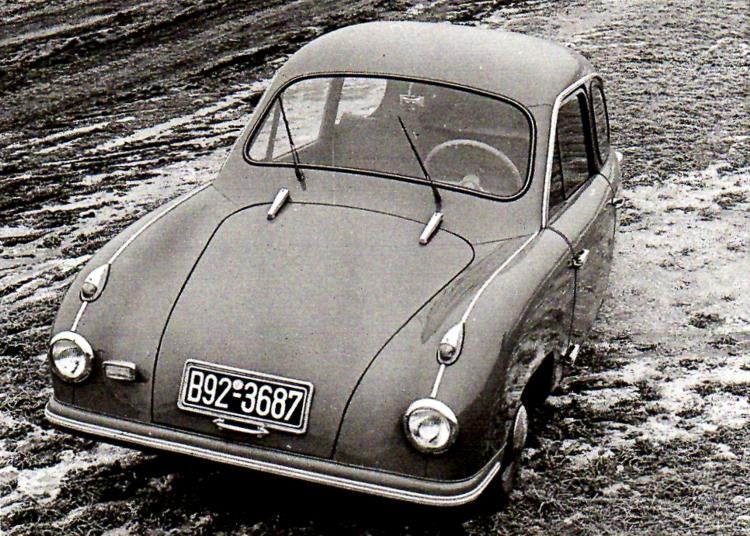
During the Golden Age of the Microcar after WWII, there were literally hundreds and hundreds of microcar companies all trying to eke out their own sliver of the automobile market. For every one that did manage to pump out a few copies, there were several that barely got off the drawing board. Microcar history is littered with weird little contraptions that never saw series production.
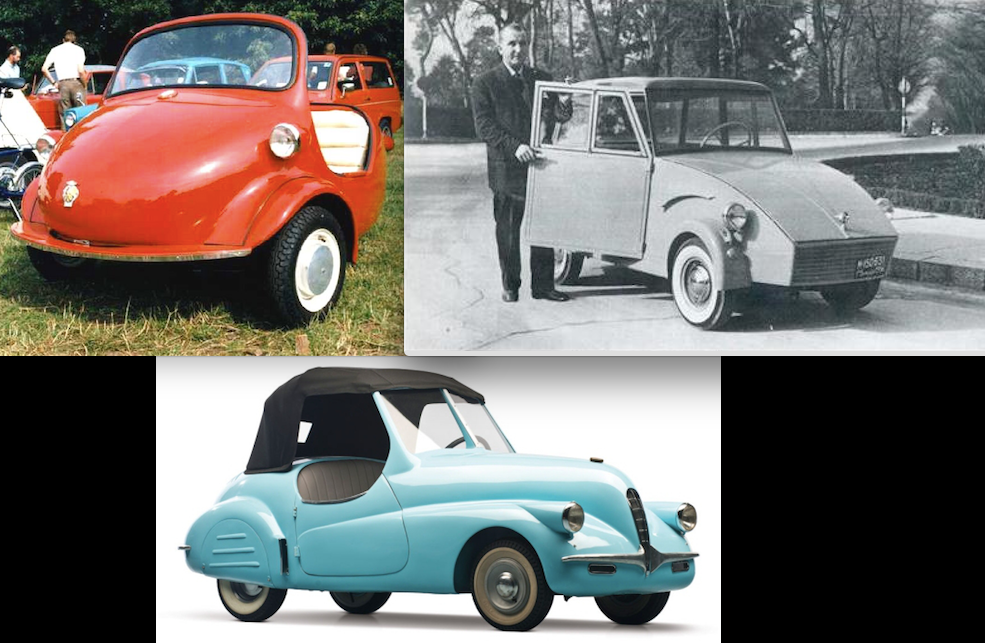
One of the more interesting ones was the adorably named German car the “Pinguin” which, believe it or not, translates to “Penguin.”
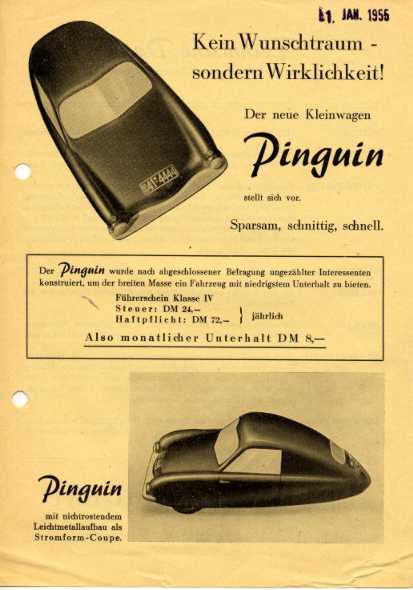
Its story begins in 1952 when the awesomely named Romanus Müthing, an agricultural machinery distributor, was fretting over a consumer boycott by farmers of said machinery because of rapidly rising prices. Manufacturing was just starting up in postwar Germany and limited production caused inflation in certain industries. Müthing had always been a car enthusiast and, like other enterprising businessmen at the time, saw the need for a cheap car in the postwar climate. Just as his business was struggling, he saw an ad looking for investors in a factory that was planning on producing a small car. The factory, called Passat-Werk, was owned by an enthusiastic engineer named Karl Faust who had previously failed at producing tractors and motorcycles based on pre-war designs. Faust, though deep in debt from the bikes and tractors, had already managed to attract one investor based on two rather interesting designs he had come up with.
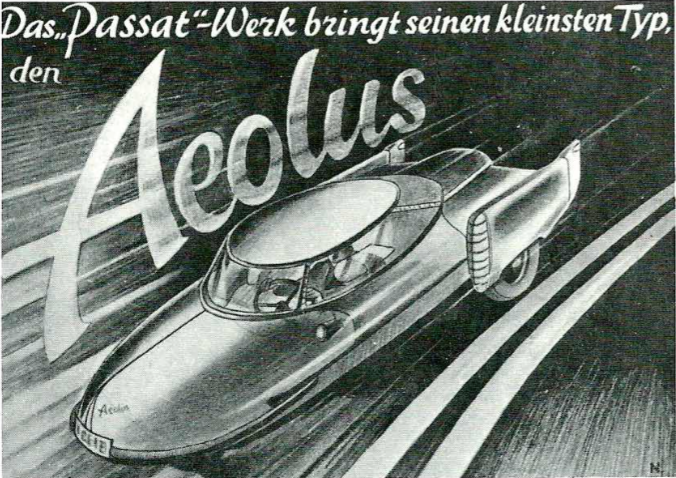
The first was the Aeolus, a wild three-wheeler that looked part u.f.o., part 50’s Cadillac. Faust was apparently aided with the design by a designer of kitchens according to period literature about the car. Together they came up with a radical microcar that was completely impractical. They decided, it being the jet age, it should have a cockpit like a plane with a hand throttle instead of a gas pedal. They planned on a belt-driven CVT transmission 5 years before DAF introduced theirs. It would seat three with the driver sitting in the middle and the passenger seats set slightly behind. The steering wheel would fold away for easy entry and exit. They planned on plexiglass windows to save weight as they envisioned a 200cc motor for power.
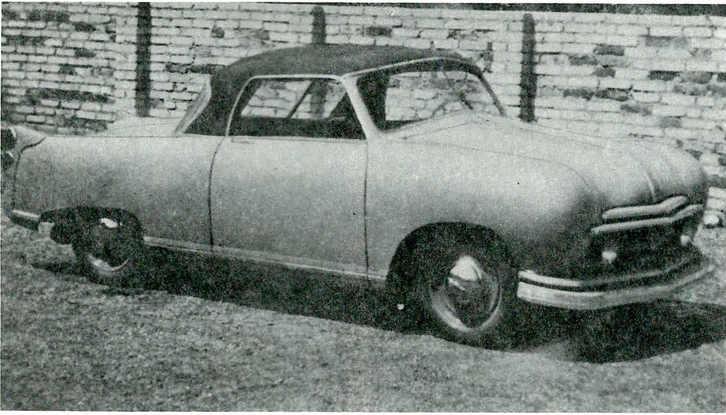
The other car was the much plainer and conventional Passat. It was rather homely and kind of angry looking, but I like the little tail fins that appear stuck on as an afterthought. It had a 600cc engine in the back, and a standard ladder frame underneath the double pontoon body.
Impressed, Müthing paid 4,000DM to become a partner. There was a prototype of the Passat already and Faust wanted now to get the Aeolus off the ground. Their plan was to show 3 of the cars at the 1953 Frankfurt Motor Show in March along with the Passat. Faust was overly optimistic and figured his factory could pump out 5 cars a week once it was up and running. In reality, he had no idea how to build the crazy thing. He had not sourced a motor, designed a chassis, or figured out how anything would be engineered. And the Motor Show was 4 months away. He did continue to sign up investors, though. Some came through with a little money, but most didn’t. And, as March drew close, it became obvious the Aeolus was never going to be a reality. They tried to get in with the Passat car, but were turned away because the prototype was too crude and not road worthy, and the company clearly didn’t have the resources to put it into production. Soon after, Faust’s factory was repossessed by the banks and the whole venture appeared dead. But, Romanus still thought building a small, affordable car was a good idea. In ’53, the market was still wide open. Messerschmitt Kabinenroller production was just getting underway, Lloyds and !!!error: Indecipherable SUB-paragraph formatting!!! were in production, but just at a trickle. The time was right. But, getting a car into production from scratch is a monumental task no matter how small it is. One of the other Passat investors, Heinz Elschenbroich shared Müthing’s vision, though, and the two men decided to give it another go. They figured they didn’t want the 20,000 or so Marks they’d already sunk into the idea to be in vain. Unfortunately, despite learning a lot with the Passat adventure, they still had no idea what they were doing.
Müthing had supplied equipment to a dairy farm run by Kurt Volkerath. Volkerath had been famous before the war for building and driving the !!!error: Indecipherable SUB-paragraph formatting!!! which were exactly what they sound like.
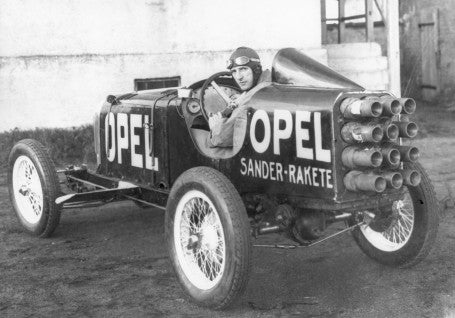
Two pre-war Opels powered by solid fuel rockets. Most of the first one’s rockets never fired, and it only made it to 47 mph on its one test run, but the Rocket Car #2 blazed to 143 when all 24 of its rockets worked perfectly. Müthing figured, like any of us would, that this was the man he needed to design a microcar.
Volkerath agreed to come on board for a healthy weekly fee. He recognized that his new employers had no experience in manufacturing automobiles, so he proposed building an aerodynamic 2+2 coupe that would fit on a Volkswagen chassis. That way all they needed to worry about was a body. But, VW wasn’t yet building their cars fast enough to spare any chassis and even used Beetle chassis were expensive, so that idea was scrapped. Instead, they decided to try a simple three-wheeler. In only a couple months, Volkerath designed and built a central backbone tube frame chassis equipped with two wheels in front and one drive wheel behind powered by a 200cc Ilo motor.
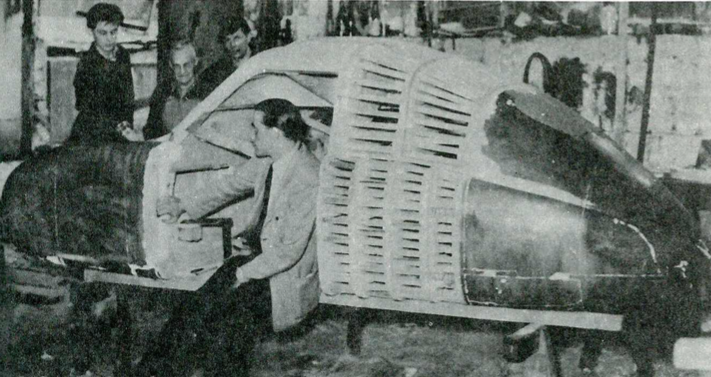
He also had constructed a scale model of an egg-shaped little car. It resembled a tiny Porsche because they planned on it having an aluminum body and the United Deutsch Metallweke (VDM) had developed a process for forming heated aluminum panels in molds. But, it only worked on round shapes.
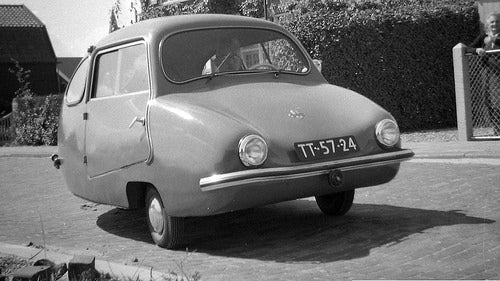
I think they may have built some of the early aluminum Porsche bodies, and Fuldamobil was using the same process for their cars which looked like if a 356 mated with a bloated tick.
By September of 1953, they had 3 prototypes paid for by Müthing and Elschenbroich which Müthing had now named the Pinguin.
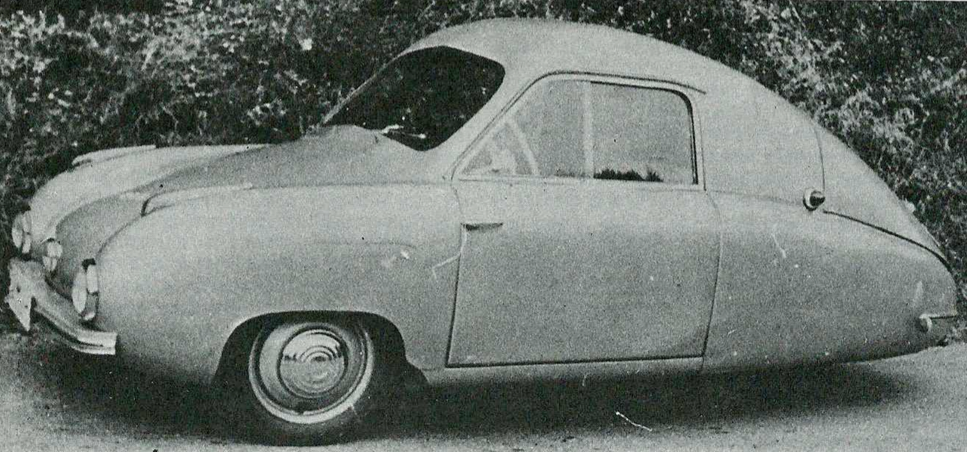
They sat three across on the single bench seat. The 9.5 HP Ilo was mated to a 3 speed transmission which powered the rear wheel by chain drive. The front wheels were suspended on swing axels with train links, there was rubber suspension all around, and steering was with rack and pinion. It looked like a pretty well sorted little car and received a lot of positive attention when it was put on display at the Frankfurt Motorcycle Show that fall. People called it the “mini Porsche.” It hadn’t, yet, been road tested, though. Ilo tested the car in a wind tunnel and calculated a drag coefficient of 0.403 which should have meant a top speed of 55 MPH. Pretty good for 9.5 horsepower.
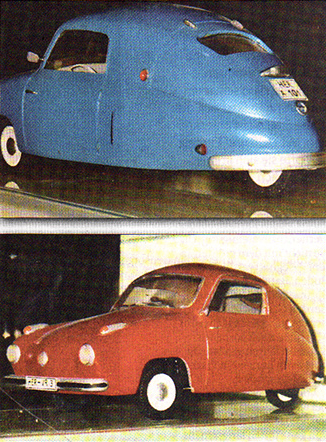
However, when they finally took the cars out on the streets, Volkerath’s spindly tube chassis fell apart. In addition, in the short time before the chassis destroyed themselves, the cars were wildly unstable. Volkerath seemed to have only been concerned with saving weight and keeping things simple. He gave no thought to his design actually working. And, since he was the only one with any car engineering experience, no one questioned him. Müthing and Elschenbroich were stunned and devastated especially when they looked at the books. They were nearing 60,000 Marks in the red. But, not wanting to quit now, Müthing fired Volkerath and turned to Norbert Stevenson, the man behind the Fuldamobil. Fuldamobils were crude, but robust, and Stevenson, a self-taught engineer, had come up with some radical ideas to make it such.
Despite funds running low, Romanus promised to double Stevenson’s salary and in early 1954, he started work on an all-new Pinguin. They kept the general body style that had won over fans the year before, but Stevenson suggested adding a back seat. He then designed a strong double tube frame. For stability, he replaced the rubber suspension with telescopic shock absorbers and coil springs. Cable brakes gave way to hydraulics, and a driveshaft replaced the noisy and unreliable chain. The car also now had a frunk and rear windows.
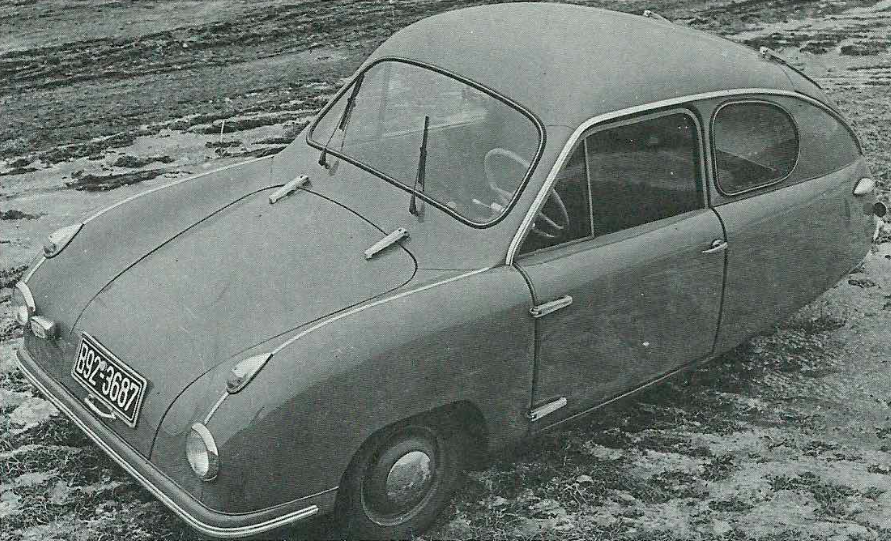
The whole thing was pretty impressive. It was handsome and had many features like turn signals and motorized windshield wipers that were absent on other microcars. And, it finally drove like a real car. Unfortunately it was heavy. It was also expensive. Romanus Müthing had finally realized his dream of making a car worthy of production, but it had cost him his life savings which had now run out. 80,000 Marks and he had one car to show for it. There was no way he and Elschenbroich could start production on their own. So, they decided to try and find a licensee. They got some interest from scooter manufacturer Hoffman, but when they ran the numbers, they figured out that the Pinguin would cost too much to make. It would end up being more expensive than a VW and for a car with three wheels that was absurd. Things weren’t helped when Müthing’s brother was seriously injured when he crashed the prototype.
Romanus had returned to selling farming equipment, but still hawked the Pinguin concept. One of his suppliers, Rotenburg Metallwerke, became intrigued by the idea of expanding into the car business. They agreed to pay for the building of two more prototypes with the promise of full production if the cars completed a 35,000 km test drive. Stevenson tweaked the design to add stability and the two new cars began a tour of Germany. The ended their journey at the Rotenburg factory whose delighted proprietors immediately ordered 10 more cars be made with full production to start in the fall of 1954 after the plant was converted. The “Three Wheeled Porsche” was announced to the press and everything looked golden. The 10 additional cars were constructed, ready to be sent to dealers who had begun to sign up. Müthing even sent a smug letter to Volkerath just to rub in how they now had a decent car after having to scrap the one he designed.
And then nothing happened. Tooling wasn’t ordered and Rotenburg kept making agricultural equipment. They told Müthing a 4 wheeled car would sell better than a 3-wheeler and ordered another redesign, but said they wouldn’t pay for it. Stevenson responded that that would make the car even more expensive, and since he couldn’t work for free, left in a huff. He would later say it was the most disorganized company he ever worked for and he would later go on to work at Ford. Also, by this time the Isetta and Goggomobil had been released, and they dominated the microcar market. The poor new Pinguins were put on ice and Rotenberg demanded Müthing figure out a way to lower production costs. Now without an engineer, the Pinguin boys took another cue from Fuldamobil and toyed with the idea of making the body out of fiberglass and farming out production to a bicycle factory. However, this would’ve ended up even more expensive after making new body molds for GRP, so, when Rotenburg was bought by another company in early 1956, the new owners abandoned the Pinguin, and Müthing and Elschenbroich were again on their own. They tried selling licenses to motorcycle manufacturers Kreidler and Horex, but the same old problem of cost caused them to pass, and by the summer of 1956 all the Pinguins had been scrapped and Romanus Müthing was out of the car business for good. He kept on selling farm machinery which was lucrative, but certainly not as sexy as building tiny Porsche lookalikes. None of the dozen Pinguins that were built remain, but VDM curiously did construct one child’s pedal car based on the design and it still lives.
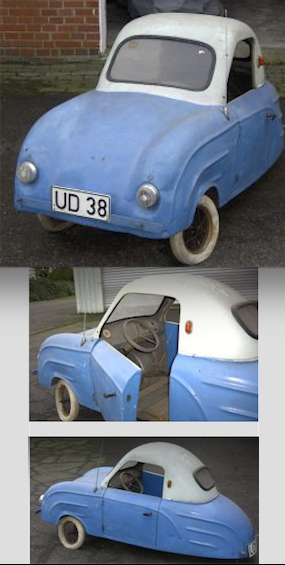
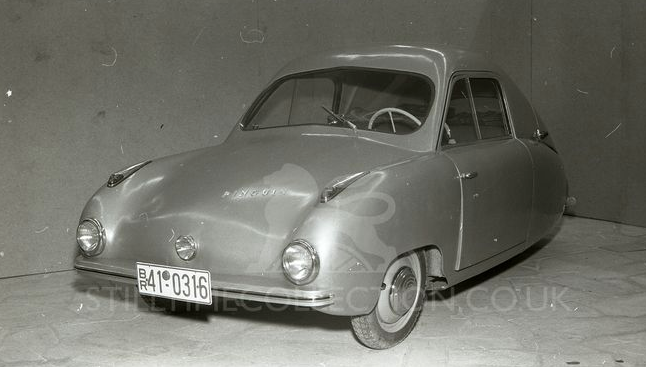
 RallyWrench
> Jonee
RallyWrench
> Jonee
07/13/2015 at 13:23 |
|
Fantastic piece, very educational!
I cannot unsee this:
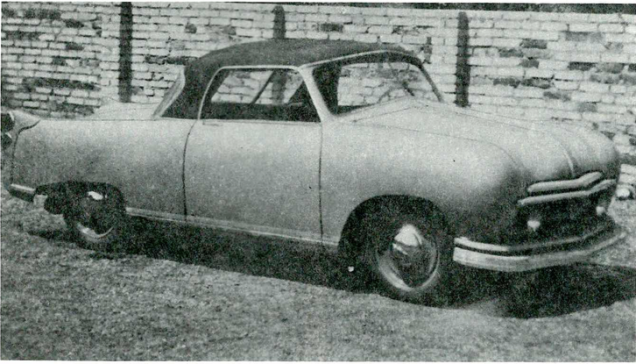

 Nibby
> Jonee
Nibby
> Jonee
07/13/2015 at 13:24 |
|
KAWAII

 Ad_absurdum_per_aspera
> Jonee
Ad_absurdum_per_aspera
> Jonee
07/13/2015 at 13:44 |
|
saw the need for a cheap car {...} The factory was owned by {...} Faust
Pity it didn’t work out — the ads could have described it as “The Faustian Bargain.”
 AfromanGTO
> Jonee
AfromanGTO
> Jonee
07/13/2015 at 14:00 |
|
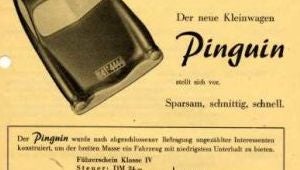
Would you be required to wear a Tux while driving this? The article never mentioned it.
 Jonee
> AfromanGTO
Jonee
> AfromanGTO
07/13/2015 at 14:10 |
|
Good question. It was an economy car, so I think tuxedo t-shirts would have been fine.
 torque
> Jonee
torque
> Jonee
07/13/2015 at 14:47 |
|
it’s really kind of amazing when you start looking in to the history of different companies how close many came to not making it, three stories that come to mind...
Henry Ford starting 2-3 failed auto companies before getting one to work
VW original beetle was in development for over 10 years b/f being sold in any numbers (plus required rebuilding the factory at British decision & control)
BMW literally 1 day away from being purchased by Mercedes-benz
 Jonee
> torque
Jonee
> torque
07/13/2015 at 14:50 |
|
It’s true. A couple shifts of fate and everyone could have been driving Pinguins instead of Beetles.
 TylerLinner
> Jonee
TylerLinner
> Jonee
07/13/2015 at 15:20 |
|
Nice article on a car I’ve never heard of!
 tapzz
> Jonee
tapzz
> Jonee
07/13/2015 at 15:56 |
|
Faust , though deep in debt from the bikes and tractors, had already managed to attract one investor based on two rather interesting designs he had come up with.
I wonder who that investor could be?
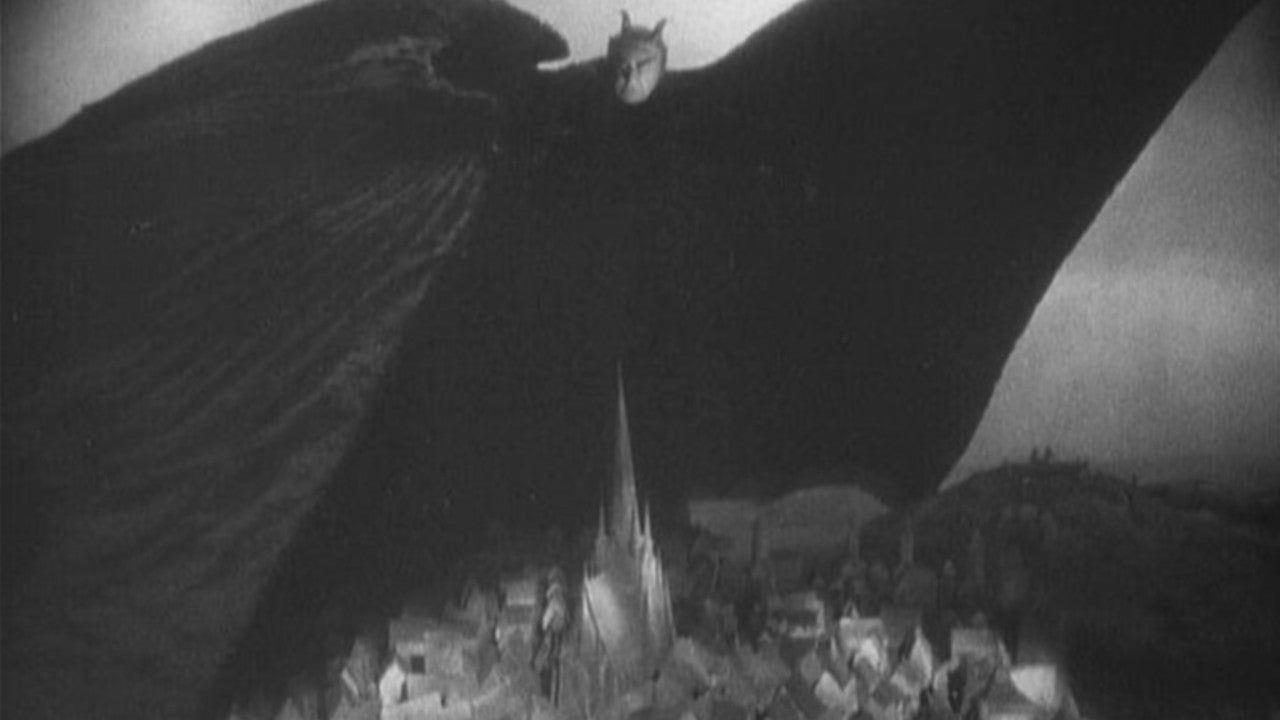
But seriously: great story about a piece of automotive history I knew nothing about.
A few nitpicks:
United Deutsch Metallweke (VDM)
Probably should be: Vereinigte Deutsche Metallwerke (VDM, United German Metalworks)
also: Kriedler Kreidler
 venivelovici
> Jonee
venivelovici
> Jonee
07/13/2015 at 15:57 |
|
Earlier in the week we had the Phaeton’s grandpa. Now the Passat’s! ;)
 gerrycomo
> Jonee
gerrycomo
> Jonee
07/13/2015 at 16:13 |
|
Any 80s children here remember the Micro-Machines car toys?
 Jonee
> tapzz
Jonee
> tapzz
07/13/2015 at 16:48 |
|
Someone should get you the ability to Kinja in red.
 Jobjoris
> Jonee
Jobjoris
> Jonee
07/14/2015 at 02:36 |
|
Sparsam. Schnittig. Schell.
I wonder how many Jägermeister was needed to call this actually Fast . But I love every bit of the Pinguin. Was about time you did something on a microcar again, had been a while. Chosing this one I can only applaud for. Great write-up, thanks for sharing!
Does it have a 3rd center headlight in that last picture? And that’s not a Fuldamobil you’re showing: it’s a Bambino 200! ;-)
 Jonee
> Jobjoris
Jonee
> Jobjoris
07/14/2015 at 02:42 |
|
I guess they were thinking that Volkerath guy was going to stick some rockets on it. Glad you liked it. I always found its story kind of interesting. I have another famous failed microcar also in the works. A real legend.
It does have a mini third headlight. I couldn’t find any information about why it’s there, but there it is. You’re right, that is a Bambino. Did you actually recognize the badge, or the Dutch license plate?
 Jobjoris
> Jonee
Jobjoris
> Jonee
07/14/2015 at 02:52 |
|
Volkerath, another truly awesome name. Especially in combination with “Herr Doktor”.
Not all of the Pinguins seem to have that third light. Could it be a directional headlight?
Noticed the license plate, zoomed the picture and saw that logo.
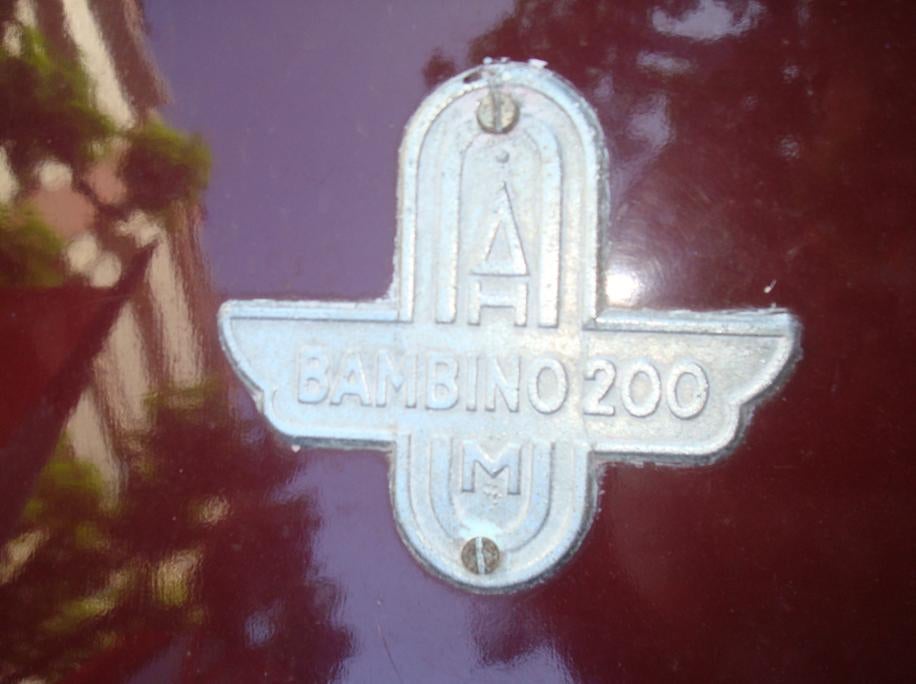
The ANWB (Dutch AA) made a small film about the first traffic jam in the Netherlands. A Bambino featured in that one. Check 1:20.
 Jonee
> Jobjoris
Jonee
> Jobjoris
07/14/2015 at 03:01 |
|
I especially liked the way Google would translate his name into “People Erath” like it was some kind of alien race.
Yeah, only the mark I Pinguin had the 3 lights. On Norbert Stevenson’s redesign, it got a front boot.
That’s funny. I think that’s the only footage of a Bambino I’ve seen. So, was it responsible for the traffic jam? Because that would make sense.
 Jobjoris
> Jonee
Jobjoris
> Jonee
07/14/2015 at 03:52 |
|
Indeed. Maybe we could use his name for a color of the Wanke r l. Volkerath Grün.
Only the Mark 1? How many were Mark 1s?
The first traffic congestion in the Netherlands was in 1925. People wanted to see how many damage was done by a storm in the east of the Netherlands so the ones with a car took and drove off. What a history my people have. Such sorrow. Such tragedy.
 ACESandEIGHTS
> RallyWrench
ACESandEIGHTS
> RallyWrench
07/14/2015 at 10:27 |
|
Fantastic story! Though you forgot to add that it’s entirely fictional. You see, every Deutschlander is born with an engineering degree, and any allegation of a failed manufacturing venture is surely communist propaganda.
 RallyWrench
> ACESandEIGHTS
RallyWrench
> ACESandEIGHTS
07/14/2015 at 12:07 |
|
Good point. I’ve known and worked with enough Germans in the automotive and racing world to know that this is absolutely true.
 Ladymopar
> Jonee
Ladymopar
> Jonee
07/14/2015 at 13:42 |
|
Awesome aticle! Love learning new things :)
 Jonee
> Jobjoris
Jonee
> Jobjoris
07/14/2015 at 13:56 |
|
That is perfect. Volkerath Grün is an epic color name. A nice tribute to a brave man who was apparently a lousy car designer.
There were 2 mark 1 Pinguins. They’re the ones that fell apart due to Herr Volkerath’s terrible chassis.
That’s amazing. Before cars, most people could only read about that kind of disaster. It must have been quite the thrill to witness it in person and in doing so create their own mess. A proud moment in Dutch history indeed. I think it would make a wonderful Oppo post.
 Jonee
> Ladymopar
Jonee
> Ladymopar
07/14/2015 at 14:29 |
|
Thanks! Glad you enjoyed it! I have a bunch more on my Kinja blog in case you’re interested and need to kill some time.
http://weird-wheels.kinja.com/
 Jobjoris
> Jonee
Jobjoris
> Jonee
07/14/2015 at 16:08 |
|
And Müthing Rot and Fulda Gelb of course.
Haha, quite some history lesson for Oppo. I don’t think it will work/generate much traffic. Your Pinguin-post did: FP again!!!! Congrats, if you’re into a career switch why don’t apply at Jalopnik’s?
 Jonee
> Jobjoris
Jonee
> Jobjoris
07/14/2015 at 18:32 |
|
Bugatti has Wimille, but we could do Benoist Blue. Maybe we can get permission to offer a Gatso Grey. Although, I’m sure people wouldn’t want something on their car named after a speed camera.
It sounds like such a kooky story, I think if told right, it would be a great post. It’s an interestingly weird bit of history. How many countries know when their first traffic jam was? And for such a fascinating reason. It really says a lot about human nature. I want to make a whole feature length documentary on the subject now.
I wouldn’t have thought the little Pinguin would have garnered that much interest, but people seemed to enjoy it. They’ve shared enough of my posts at this point, they should just hire me. I’d love to write for Jalopnik. I could see myself spending all my days researching obscure cars. Who wouldn’t want to do that? They already have Torch, though. But, he’s always ripping us off, so why not cut out the middle man and bring me aboard?
 Jobjoris
> Jonee
Jobjoris
> Jonee
07/15/2015 at 02:41 |
|
The Gatso we could use in the accessory-part, what about a dash-cam, the Gatso. Even formed like a Gatsometer?
Well, you’re probably right. But then again I’m not sure if Oppo is the right place for it. Jalopnik would be probably. And they really should hire you. And me. For research.
 Ladymopar
> Jonee
Ladymopar
> Jonee
07/15/2015 at 12:23 |
|
Thanks I will check it out, I love all cars. Our car show that I put together, I pick a car and participants have to guess the country of origin and what it is for a prize-it’s super fun and I get to meet everyone. no googling it either.
I also use it at the hotel, it is an international one, it breaks the ice when I know the cars of our guests country :)
 Fresh-Outta-Nissans
> Jonee
Fresh-Outta-Nissans
> Jonee
07/17/2015 at 00:15 |
|
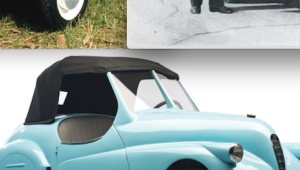
It looks like that anthropomorphic brainy dog! What’s he called?
 Jonee
> Fresh-Outta-Nissans
Jonee
> Fresh-Outta-Nissans
07/17/2015 at 00:18 |
|
Mr. Peabody? Haha.
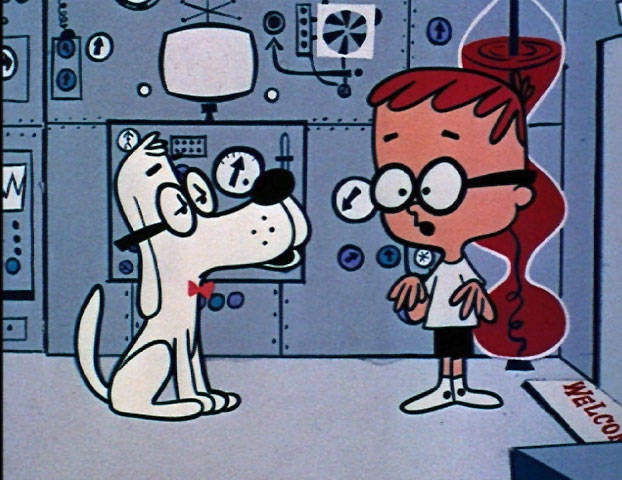
 Fresh-Outta-Nissans
> Jonee
Fresh-Outta-Nissans
> Jonee
07/17/2015 at 04:20 |
|
Word. Also, proved my point.